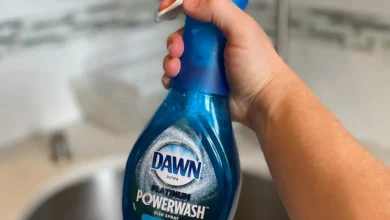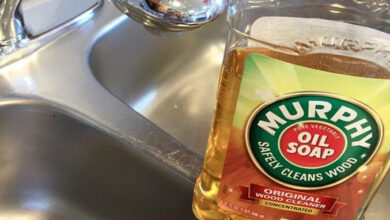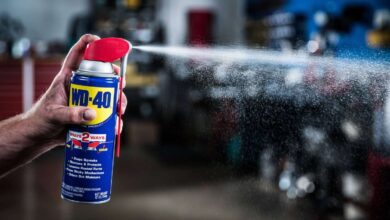Electronics, especially screens, tend to attract dust and fingerprints. Use an anti-static cleaning cloth to wipe down screens and other surfaces. These cloths not only remove dust but also help prevent it from resettling quickly. Be sure to power off electronic devices before cleaning to avoid any potential damage. For a streak-free finish, use gentle, circular motions while cleaning screens and follow the manufacturer’s recommendations for cleaning solutions.
Blinds Brilliance:
Cleaning blinds can be a tedious task, but a simple hack using kitchen tongs and microfiber cloths can make it more manageable. Wrap a microfiber cloth around each tong, securing it with rubber bands or clips. This method allows you to clean both sides of the blinds simultaneously, saving time and effort. For a thorough clean, consider using a homemade dusting spray or a mixture of water and white vinegar. Wipe down each slat carefully, ensuring you reach every nook and cranny for a dust-free finish.
Socks as Dust Mittens:
When in a pinch for dusting tools, repurpose old socks as makeshift dust mittens. Slip them onto your hands and use them to wipe down surfaces such as shelves, countertops, and baseboards. The texture of the fabric naturally attracts and holds onto dust, and the flexibility of the sock allows you to reach into corners and tight spaces with ease. Consider washing the socks after use, or designate a few pairs specifically for dusting to avoid spreading dirt and dust unintentionally.
Dusting Spray DIY:

For an eco-friendly and effective dusting solution, create your own DIY dusting spray. Mix equal parts water and white vinegar in a spray bottle, adding a few drops of your favorite essential oil for a pleasant scent. White vinegar not only helps break down and lift dust but also has antimicrobial properties. This homemade solution is safe for most surfaces, including wood and glass, making it a versatile and cost-effective alternative to commercial dusting sprays.
Furry Friend Duster:
If you have pets, you know that managing pet hair can be an ongoing battle. To tackle fur on fabric surfaces, wrap a squeegee with a microfiber cloth. The rubber edge of the squeegee helps lift pet hair, while the microfiber cloth captures it. Glide the wrapped squeegee over sofas, chairs, and other upholstered furniture to quickly and efficiently remove pet hair and dust. Regular use of this method can significantly reduce allergens and keep your home looking cleaner and more pet-friendly.
Vent Covers Unveiled:
Vent covers can quickly accumulate dust, especially in HVAC systems. Regularly remove and clean vent covers to prevent the circulation of dusty air throughout your home. Use a vacuum cleaner attachment or a brush to loosen and remove dust from both sides of the cover. For stubborn grime, consider soaking vent covers in warm, soapy water, but be sure they are completely dry before reattaching to prevent mold growth. This simple step contributes to better indoor air quality and a more efficient heating and cooling system.
Feather Duster Finesse:
Traditional feather dusters can sometimes disperse dust rather than capture it. Opt for an ostrich feather duster, as the soft and dense feathers attract and hold onto dust effectively. Ostrich feathers are also less likely to scratch delicate surfaces. Shake the feather duster outside after use to release trapped dust, and periodically wash the feathers with a mild detergent to maintain their dust-collecting prowess. This gentle but efficient tool is perfect for quick and regular dusting.
Top-to-Bottom Technique:
When tackling dusting tasks, adopt a top-to-bottom approach for a more systematic and efficient cleaning routine. Begin by dusting higher surfaces such as shelves, cabinets, and light fixtures before moving downward to tables, countertops, and baseboards. This strategy ensures that any dust dislodged from higher areas falls onto surfaces that haven’t been cleaned yet, preventing the need for re-cleaning. Consistently following the top-to-bottom technique streamlines your cleaning process and maintains a dust-free home.
Air Purifiers for Dust Control:
To supplement your dusting efforts, invest in air purifiers equipped with High-Efficiency Particulate Air (HEPA) filters. These filters are designed to capture and trap microscopic particles, including dust, pet dander, and pollen. Place air purifiers strategically in high-traffic areas or bedrooms to enhance indoor air quality continuously. Regularly replace or clean the HEPA filters according to the manufacturer’s recommendations to ensure optimal performance. The combined effort of dusting and using air purifiers creates a healthier living environment for you and your family.
Dusting High and Low:
Dust settles on surfaces both high and low, so it’s essential to address all areas during your cleaning routine. Don’t overlook light fixtures, ceiling corners, and moldings, as these areas can harbor hidden dust. Utilize an extendable duster or a microfiber cloth attached to a long-handled mop to reach high places safely. For low areas, such as baseboards and floor-level surfaces, use a smaller tool or a handheld vacuum to ensure thorough dust removal. Comprehensive dusting, covering both high and low spaces, contributes to a consistently clean home.
Mattress Matters:
The mattress is a commonly overlooked source of dust and allergens in the bedroom. Regularly vacuum your mattress using a vacuum cleaner with a HEPA filter to effectively remove dust mites, dead skin cells, and other debris. Consider using a mattress protector to create an additional barrier against dust mites and spills. Rotate and flip your mattress according to the manufacturer’s guidelines to promote even wear and prevent the buildup of dust in specific areas. This attention to mattress care not only improves sleep quality but also contributes to a healthier bedroom environment.
Doorway Dusting:
Doors and door frames are frequently touched surfaces that can accumulate dust and grime over time. Incorporate these areas into your regular dusting routine by using a damp microfiber cloth to wipe down the surfaces. Pay special attention to doorknobs and handles, as these can harbor germs in addition to dust. For wooden doors, use a mild wood cleaner to maintain the finish and protect against dust buildup. Keeping doorways clean not only enhances the appearance of your home but also contributes to a more hygienic living space.
Bookshelf Brilliance:
Bookshelves are not only storage spaces but also dust magnets due to the presence of books and decorative items. When dusting bookshelves, start by removing all items from the shelves. Use a microfiber cloth or a soft brush to dust each book individually, paying attention to the tops and sides. Dust the shelves themselves, and take the opportunity to reorganize and declutter as you return items to their places. This method ensures thorough dusting while maintaining the integrity of your book collection and preventing dust from settling between books.
Dust-Repellent Bedding:
Selecting dust-resistant pillowcases and mattress covers can significantly reduce the accumulation of dust mites and allergens in your bedding. Look for hypoallergenic materials and tightly woven fabrics to create a barrier against dust. Wash bedding, including pillowcases, sheets, and mattress covers, regularly in hot water to eliminate dust mites and bacteria. Additionally, rotate and fluff pillows to prevent the settling of dust in the fill. Investing in dust-repellent bedding contributes to a cleaner and healthier sleep environment.
Floor Mats at Entrances:
Prevent dust and dirt from entering your home by strategically placing floor mats at entrances. Choose mats with a textured surface to trap and collect debris from shoes. Encourage family members and guests to wipe their feet before entering the house to minimize the transfer of outdoor dust. Regularly shake out or vacuum the mats to remove accumulated dirt. This simple practice not only keeps your floors cleaner but also reduces the need for frequent dusting throughout the home.
Vacuum Attachments Galore:
Most vacuum cleaners come with a variety of attachments designed for different surfaces and cleaning needs. Utilize these attachments to enhance your dusting efforts. Crevice tools are ideal for reaching tight spaces and corners, upholstery brushes can effectively remove dust from furniture, and dusting brushes are designed to handle delicate surfaces. Familiarize yourself with the capabilities of each attachment and use them strategically to achieve a comprehensive dust-free clean in various areas of your home.
Cabinet Clean-Up:

Cabinets and cupboards can harbor dust, especially in the corners and on the tops of shelves. When dusting these areas, start by emptying the contents of each cabinet. Use a damp microfiber cloth or a soft brush to remove dust from both the interior and exterior surfaces. Take the opportunity to declutter and organize as you return items to the cabinets. Regular cabinet clean-ups not only contribute to a dust-free home but also make it easier to find and access your belongings.
Shoe-Free Zone:
Implementing a shoe-free policy indoors can significantly reduce the amount of dust and dirt brought into your home. Provide a designated area for shoes near entrances, such as a shoe rack or a designated basket. Encourage family members and guests to remove their shoes upon entering to prevent outdoor debris from spreading throughout the house. This practice not only contributes to a cleaner living environment but also reduces the frequency of dusting and floor cleaning.
Window Sill Savior:
Window sills and tracks are prone to collecting dust, pollen, and insect debris. Use a small broom or a paintbrush to sweep away loose dust from these areas. Follow up with a damp microfiber cloth to wipe down the sills and tracks thoroughly. For stubborn grime, consider using a mixture of water and white vinegar for added cleaning power. Regular attention to window sills ensures that accumulated dust doesn’t get circulated into the air when windows are opened or closed.
Carpet Care:
Carpets and rugs can trap a significant amount of dust and allergens, impacting indoor air quality. Regular vacuuming is essential to remove surface dust, but consider using vacuum attachments for a more thorough cleaning. Use a carpet brush attachment to agitate and lift embedded dirt, and pay special attention to high-traffic areas. Additionally, schedule professional carpet cleaning periodically to eliminate deeply embedded dust particles and maintain the overall cleanliness of your carpets.
Dryer Sheet Dusting:

Used dryer sheets have a residual coating that can effectively repel dust. Wipe down surfaces with a used dryer sheet to not only remove dust but also create a dust-resistant barrier. This method works well on various surfaces, including furniture, electronics, and baseboards. The pleasant fragrance from the dryer sheet adds a subtle freshness to your living space. Keep a stash of used dryer sheets for quick and efficient dusting between more thorough cleaning sessions.
Broom Brilliance:
Before sweeping, lightly misting the broom with water can help prevent dust from resettling as you clean. The moisture helps weigh down dust particles, keeping them from becoming airborne and settling on nearby surfaces. This simple trick is particularly useful when sweeping hardwood or tile floors, where dust tends to become easily airborne. Additionally, consider using a broom with soft, fine bristles to capture and hold onto dust effectively. Regularly clean the broom bristles to maintain optimal dust-collecting efficiency.
Dusting Routine:
Establishing a regular dusting routine is essential for maintaining a consistently clean home. Depending on your living situation and lifestyle, create a schedule that suits your needs. High-traffic areas and frequently touched surfaces may require more frequent dusting. Consistency is key to preventing dust buildup and ensuring a healthier living environment. Set aside dedicated time for dusting as part of your overall cleaning routine, and consider using reminders or a cleaning calendar to stay on track.
Duct Cleaning:
Professional duct cleaning is crucial for eliminating accumulated dust and allergens in your home’s HVAC system. Over time, dust can settle in ducts, reducing the efficiency of the system and contributing to indoor air pollution. Schedule duct cleaning services periodically to remove dust, mold, and other contaminants. This not only improves the air quality in your home but also enhances the performance of your heating and cooling system. Follow the recommendations of HVAC professionals for the frequency of duct cleaning based on your specific circumstances.
Pet Grooming Station:
If you have pets, designate a specific area for grooming to minimize the spread of fur and dander throughout your home. Grooming tools such as brushes and combs can effectively capture loose pet hair before it has a chance to settle on furniture and surfaces. Regular grooming not only reduces the amount of airborne allergens but also keeps your pet’s coat healthy. Consider placing a mat or towel in the grooming area to collect stray hairs and make cleanup easier. This practice contributes to a cleaner and more pet-friendly living space.
Dust-Repellent Bedding:
Choosing dust-resistant pillowcases and mattress covers is a proactive measure to reduce the presence of dust mites in your sleeping environment. These specially designed covers create a barrier that inhibits dust mites from colonizing pillows and mattresses. By investing in dust-repellent bedding, you not only enhance the longevity of your pillows and mattress but also create a cleaner and safer sleeping space. This hack is particularly beneficial for individuals with allergies or respiratory sensitivities.
Floor Mats at Entrances:
Placing floor mats at entrances is a preventative measure to trap dust and dirt before they enter your home. These mats act as the first line of defense against outdoor contaminants, reducing the amount of dust that spreads to other areas. Regularly cleaning and shaking out the mats prevent accumulated dirt from being tracked further into your living space. This simple yet effective hack contributes to a cleaner and safer home environment, especially in households with high foot traffic.
Vacuum Attachments Galore:
Making the most of various vacuum attachments is essential for addressing different surfaces and areas in your home. Crevice tools, upholstery brushes, and dusting brushes are valuable accessories that enhance the versatility of your vacuum cleaner. By using the appropriate attachment for each task, you achieve a more thorough and effective clean. This method not only removes surface dust but also tackles hidden particles, contributing to a cleaner and healthier indoor environment.
Cabinet Clean-Up:
Emptying cabinets and cupboards before dusting is a practical step to ensure a comprehensive cleaning. By removing items, you create unobstructed access to all surfaces inside the cabinets. Dust and debris can accumulate in corners and on shelving, so this method allows you to address these hidden areas. Regular cabinet clean-up not only maintains a tidy and organized space but also contributes to a cleaner and safer home environment.
Shoe-Free Zone:
Implementing a shoe-free policy indoors is a preventative measure to minimize the introduction of outdoor dust and dirt. Shoes can track various contaminants, including pollen, bacteria, and chemicals from outdoor surfaces. By designating an area for shoe removal, you reduce the risk of dust spreading to different areas of your home. This practice is particularly beneficial for households with infants, young children, or individuals with respiratory sensitivities.
Incorporating these 34 dusting hacks into your cleaning routine provides a comprehensive approach to maintaining a cleaner, safer, and healthier home. From utilizing specialized tools to implementing preventative measures, these tips address various aspects of dust control and contribute to an improved living environment. By making these practices a regular part of your household maintenance, you can enjoy the benefits of reduced dust, enhanced indoor air quality, and a more comfortable living space for you and your family.
31 Dusting Hacks To Implement For A Safer Home

Instructions
Microfiber Magic
Ventilation First
Ceiling Fan Savior
Furniture Brush-Off
Static-Free Screens
Blinds Brilliance
Socks as Dust Mittens
Dusting Spray DIY
Furry Friend Duster
Vent Covers Unveiled
Feather Duster Finesse
Top-to-Bottom Technique
Air Purifiers for Dust Control
Dusting High and Low
Mattress Matters
Doorway Dusting
Bookshelf Brilliance
Dust-Repellent Bedding
Floor Mats at Entrances
Vacuum Attachments Galore
Cabinet Clean-Up
Shoe-Free Zone
Window Sill Savior
Carpet Care
Dryer Sheet Dusting
Broom Brilliance
Dusting Routine
Duct Cleaning
Pet Grooming Station
Natural Air Fresheners




